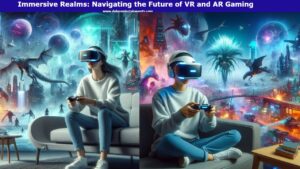Introduction:
In recent years, two technologies, in particular, have captured the imagination of gamers and developers alike: Virtual Reality (VR) and Augmented Reality (AR). Both promise immersive experiences that blur the lines between the virtual and real worlds. In this blog post, we’ll explore the potential of VR and AR in gaming, examining their respective strengths, weaknesses, and future trajectories.
As technology advances, the gaming industry continues to evolve, offering players more immersive experiences than ever before. Two prominent technologies at the forefront of this evolution are Virtual Reality (VR) and Augmented Reality (AR). Both have the potential to revolutionize the way we play games, but which one holds the key to the future of gaming?
Understanding Virtual Reality:
Virtual Reality (VR) transports players to entirely virtual environments, immersing them in a simulated reality through specialized headsets and motion-tracking technology. With VR, players can step into fantastical worlds, interact with virtual objects, and experience games in a whole new dimension. From thrilling adventures to immersive simulations, VR offers unparalleled immersion and presence, making players feel like they’re truly part of the game world.

Virtual Reality (VR) transports players to entirely virtual environments, immersing them in a simulated reality through specialized headsets and motion-tracking technology. With VR, players can step into fantastical worlds, interact with virtual objects, and experience games in a whole new dimension. From thrilling adventures to immersive simulations, VR offers unparalleled immersion and presence, making players feel like they’re truly part of the game world.
Strengths of VR in Gaming:
Innovative Gameplay: VR opens up new possibilities for gameplay mechanics, such as realistic movement and interactions, which can’t be replicated in traditional gaming.
Enhanced Storytelling: VR enables developers to craft narratives that players can experience firsthand, creating deeper emotional connections and engagement.
Social VR: Multiplayer VR experiences allow players to connect with friends and strangers in virtual spaces, fostering social interaction and collaboration.
Expanded Genres: VR has the potential to revolutionize various gaming genres, from action-packed shooters to serene exploration games, offering fresh experiences for players.
Challenges and Limitations of Virtual Reality:
Virtual Reality (VR) has captivated imaginations with its promise of immersive experiences and transformative potential. However, like any emerging technology, VR also faces its share of challenges and limitations. In this article, we’ll explore some of the key obstacles that VR must overcome to realize its full potential, from technical constraints to practical considerations.

Hardware Limitations: One of the primary challenges facing VR is the hardware required to deliver immersive experiences. High-quality VR systems demand powerful computing hardware to render complex environments in real-time and display them at high resolutions.
Motion Sickness and Discomfort: Motion sickness remains a significant challenge for many VR users, especially during experiences that involve rapid movements or intense visuals.
Content Creation and Adoption: While VR has seen growth in content creation, there remains a shortage of high-quality, compelling experiences that fully leverage the medium’s capabilities.
User Interface and Interaction Design: Designing intuitive and user-friendly interfaces for VR presents unique challenges compared to traditional 2D interfaces. VR environments require interfaces that are both functional and immersive, providing users with natural ways to interact with virtual objects and navigate virtual spaces.
Accessibility and Inclusivity: Ensuring accessibility and inclusivity in VR experiences remains a significant challenge. VR hardware and software must accommodate users with diverse abilities and needs, including those with physical disabilities, sensory impairments, and cognitive differences.
Ethical and Social Implications:
As VR technology becomes more immersive and lifelike, it raises ethical and social questions about its potential impact on users’ perceptions, behaviors, and well-being. Issues such as privacy, consent, and digital identity become increasingly relevant in VR environments, where users may feel a heightened sense of presence and vulnerability.
Understanding Augmented Reality:
Augmented Reality (AR) overlays digital content onto the real world, blending virtual elements with the user’s physical environment through smartphones, tablets, or AR glasses. AR allows players to interact with virtual objects and characters in their real-world surroundings, creating mixed-reality experiences that bridge the gap between fiction and reality.

The Promise of Augmented Reality in Gaming:
Real-World Integration: AR seamlessly integrates virtual content into the player’s real-world environment, enhancing immersion and believability.
Location-Based Experiences: AR enables location-based gaming experiences, where players can explore their surroundings and discover hidden treasures or challenges.
Social AR: AR multiplayer games encourage social interaction and collaboration, as players interact with virtual objects and each other in shared physical spaces.
Accessibility: AR experiences can be accessed through smartphones and tablets, making them more accessible to a broader audience.
Challenges and Limitations of Augmented Reality:

Technical Limitations: AR technology is still evolving, and current implementations may suffer from technical challenges such as tracking issues or inconsistent performance.
User Experience: AR experiences may vary depending on factors such as lighting conditions, physical space, and device capabilities, leading to inconsistent user experiences.
Privacy Concerns: AR raises privacy concerns related to data collection and the blending of virtual and real-world information.
Content Creation: Developing high-quality AR content can be challenging and resource-intensive, limiting the availability of compelling AR gaming experiences.
The Future of Gaming: Virtual Reality vs. Augmented Reality:
While both Virtual Reality and Augmented Reality offer exciting opportunities for gaming, they cater to different preferences and playstyles. Virtual Reality excels at delivering immersive, escapist experiences, transporting players to virtual worlds where they can lose themselves in the game. Augmented Reality, on the other hand, integrates gaming seamlessly into the real world, offering new forms of interactive entertainment that leverage the player’s physical surroundings.

Looking ahead, the future of gaming is likely to feature a blend of Virtual Reality and Augmented Reality experiences, each serving different purposes and catering to diverse player preferences. As both technologies continue to evolve and mature, we can expect to see increasingly innovative and compelling gaming experiences that push the boundaries of what’s possible.
Conclusion:
Virtual Reality and Augmented Reality represent two distinct but complementary approaches to gaming, each offering unique benefits and challenges. Whether players seek immersive virtual worlds or interactive real-world experiences, both VR and AR have the potential to transform the way we play and experience games. As technology advances and adoption grows, the future of gaming will be shaped by the convergence of these two exciting technologies, opening up new possibilities for players and developers alike.

